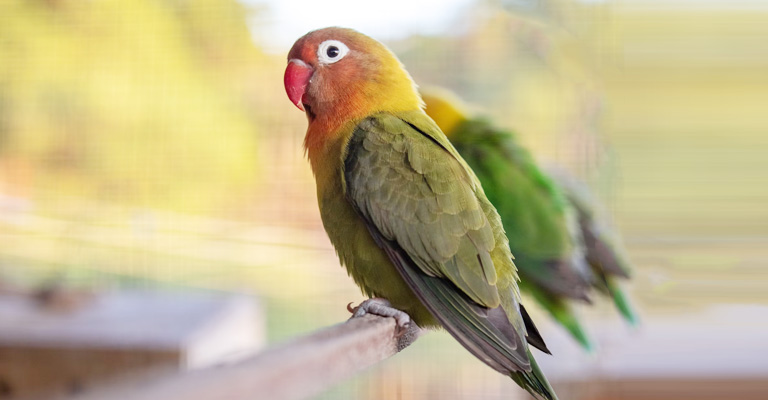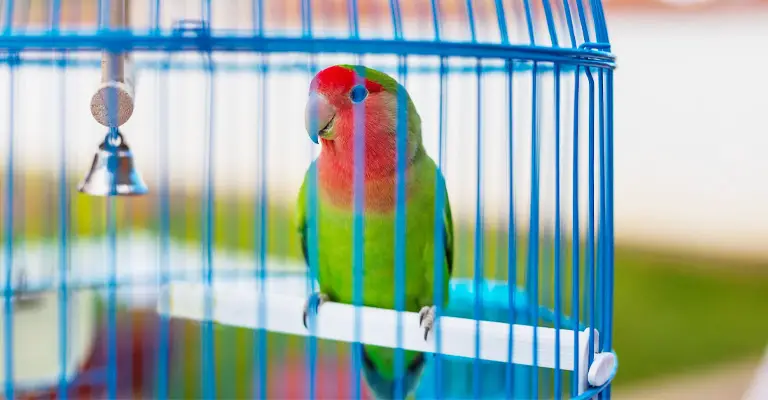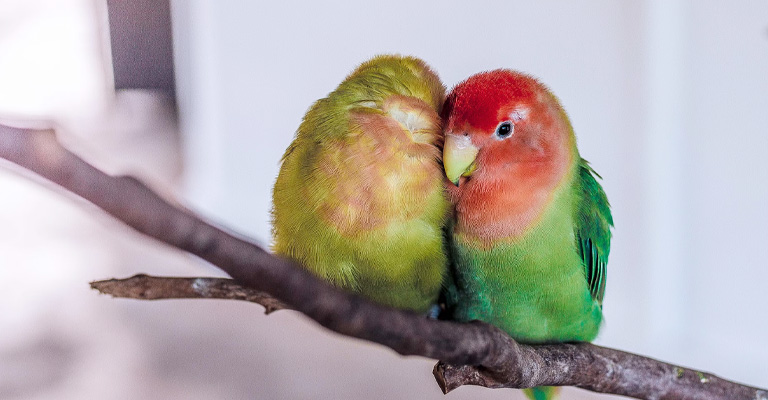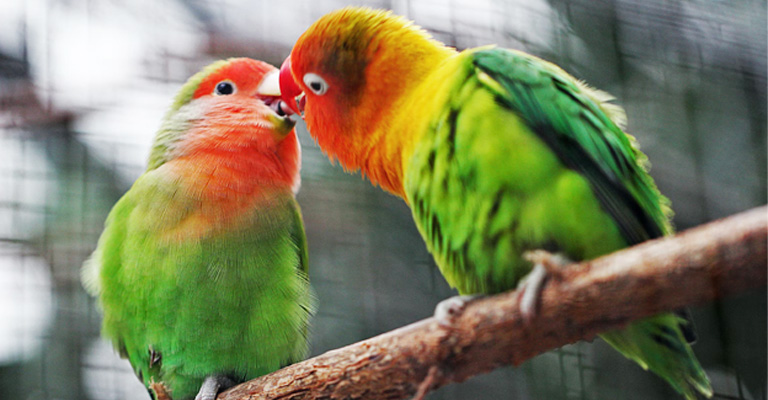Lovebirds, with their vibrant plumage and affectionate nature, make delightful companions for bird enthusiasts. But have you ever wondered about their lifespan? The longevity of these charming parrots is crucial for providing them with the best care and ensuring a fulfilling life together.
In this blog post, we will delve into the fascinating world of lovebirds and explore the question ‘How Long Do Lovebirds Live?’. From species differences to the impact of diet, environment, and social interaction, we will uncover the secrets to extending your lovebird’s years of joy and companionship.
Whether you’re a seasoned lovebird owner or considering bringing one into your home, this information will empower you to create a nurturing environment that promotes a longer and healthier life for your feathered friend. Stay focused.

Factors Affecting Lovebird Lifespan
The lifespan of a lovebird, a small parrot species known for its affectionate behavior and vibrant plumage, can vary depending on several factors. Here are some of the key factors that can affect the lifespan of lovebirds:
Species and Genetics
- Lovebirds belong to various species, such as Peach-faced, Fischer’s, Masked, and more. The lifespan can vary between species, with some living longer than others.
- Genetics plays a significant role. Birds with a strong genetic lineage may have a better chance of living longer and healthier lives.
Diet and Nutrition
- Proper diet and nutrition are essential for the health and longevity of lovebirds. A well-balanced diet that includes a variety of fresh fruits, vegetables, high-quality pellets, and seeds can help ensure they receive the necessary nutrients.
- A poor diet can lead to nutritional deficiencies and various health problems that can shorten their lifespan.
Housing and Environment
- Providing a clean and spacious cage or aviary is crucial for lovebirds. A cramped or unsanitary environment can lead to stress and health issues.
- Ensure that the temperature, humidity, and lighting are suitable for their species and individual needs.
Social Interaction
- Lovebirds are social birds and thrive on social interaction. Isolation and lack of mental stimulation can lead to boredom, depression, and a shortened lifespan.
- Regular interaction with their owners and, ideally, the companionship of another lovebird can contribute to their overall well-being.
Veterinary Care
- Regular check-ups with an avian veterinarian are essential to monitor their health and detect potential problems early.
- Prompt medical attention for illnesses or injuries can greatly impact their chances of recovery and a longer life.
Exercise and Enrichment
- Lovebirds need physical and mental stimulation. Providing toys, perches, and opportunities for exercise can help keep them active and engaged.
- Flying within a safe and controlled environment is also essential for their well-being.
Stress and Social Hierarchy
- Lovebirds have complex social structures and can experience stress if they don’t establish clear hierarchies in a multi-bird household.
- Ensure that there are no aggressive conflicts or bullying among your lovebirds.
Avoiding Toxins
- Keep lovebirds away from toxic substances such as tobacco smoke, household chemicals, and certain plants.
- Be cautious about using non-stick cookware and scented candles, which can release fumes harmful to birds.
Age at Acquisition
The age at which you acquire your lovebird can influence its lifespan. Birds that are hand-raised from a young age and receive proper care tend to adapt better to human interaction and are often healthier.
Genetics and Health History
Knowing the health history and genetics of your lovebird, if possible, can provide insights into potential health issues and the likelihood of a longer life.
Each lovebird is unique, and their lifespan can vary widely based on these factors. By providing a loving and supportive environment, you can help ensure your lovebird lives a happy and healthy life.
How Long Do Lovebirds Live?

Lovebirds, popular for their affectionate nature and vibrant plumage, typically have a lifespan of 10 to 15 years in captivity when well cared for. However, several factors influence their longevity. Genetics plays a role, with some species living longer than others.
Diet and nutrition are crucial; a balanced diet rich in fresh fruits, vegetables, and high-quality pellets can contribute to a longer life. Proper housing, social interaction, exercise, and mental stimulation are equally vital.
Lovebirds thrive on companionship and social bonding, so interaction with owners or fellow lovebirds can significantly impact their lifespan. Regular veterinary care is essential to monitor their health.
By addressing these factors and providing a nurturing environment, lovebird owners can maximize their pets’ lifespan and enjoy their charming company for many years.
Different Lovebird Species and Lifespan
Lovebirds are a diverse group of small parrots, and the lifespan of these birds can vary depending on the specific species. Here are some of the most common lovebird species and their typical lifespans in captivity:
Peach-faced Lovebird (Agapornis roseicollis)
Lifespan: Peach-faced lovebirds are known for their relatively long lifespan in captivity, which can range from 12 to 15 years or even longer with proper care.
Fischer’s Lovebird (Agapornis fischeri)
Lifespan: Fischer’s lovebirds generally have a lifespan of 10 to 15 years when kept in a suitable environment.
Masked Lovebird (Agapornis personatus)
Lifespan: Masked lovebirds typically live for 10 to 15 years in captivity, with some individuals exceeding this range.
Nyasa Lovebird (Agapornis lilianae)
Lifespan: Nyasa lovebirds have a slightly shorter lifespan, usually ranging from 8 to 12 years.
Black-cheeked Lovebird (Agapornis nigrigenis)
Lifespan: Black-cheeked lovebirds can live for around 10 to 15 years with proper care.
Red-headed Lovebird (Agapornis pullarius)
Lifespan: Red-headed lovebirds generally have a lifespan of 10 to 15 years when well-maintained.
Lilian’s Lovebird (Agapornis lilianae)
Lifespan: Lilian’s lovebirds have a similar lifespan to Nyasa lovebirds, typically living for 8 to 12 years.
It’s important to note that these are general lifespan ranges, and individual birds may live longer or shorter lives based on their genetics, diet, environment, and overall care. Providing a loving, healthy, and stimulating environment can help maximize the lifespan of any lovebird species.
Tips for Extending Your Lovebird’s Lifespan

Extending your lovebird’s lifespan requires providing them with a healthy and nurturing environment. Here are some tips to help you maximize the lifespan of your beloved pet:
Nutrition and Diet
- Offer a well-balanced diet that includes a variety of fresh fruits, vegetables, high-quality pellets, and seeds suitable for lovebirds.
- Avoid high-fat and sugary treats, as well as toxic foods like avocado and chocolate.
Clean and Safe Environment
- Maintain a clean cage or aviary to prevent the buildup of harmful bacteria.
- Ensure there are no sharp objects, toxic plants, or potential hazards in their living space.
Social Interaction
- Lovebirds are social birds; provide regular interaction and companionship to prevent loneliness and depression.
- Consider having a pair of lovebirds if possible, as they often thrive with a companion.
Exercise and Mental Stimulation
- Provide toys, perches, and opportunities for physical and mental exercise.
- Allow them to explore outside their cage in a safe environment.
Regular Veterinary Care
- Schedule regular check-ups with an avian veterinarian to detect and address health issues early.
- Keep vaccinations and parasite prevention up to date.
Avoid Stress
- Minimize exposure to loud noises, extreme temperatures, and stressful situations.
- Ensure there is no aggressive behavior or bullying among multiple lovebirds.
Hydration
Provide clean, fresh water daily to prevent dehydration.
Grooming
- Trim your lovebird’s nails and beak as needed to prevent overgrowth.
- Provide opportunities for bathing or misting to keep their feathers clean.
Toxin Awareness
- Keep your lovebird away from toxic substances like tobacco smoke, household chemicals, and certain plants.
- Use bird-safe cleaning products in their vicinity.
Monitor Weight and Behavior
Keep an eye on changes in weight and behavior, as these can be early signs of health issues.
Proper Lighting
Ensure your lovebird gets exposure to natural sunlight or provide full-spectrum UVB lighting to support their vitamin D metabolism.
Avoid Overbreeding
If you’re breeding lovebirds, be cautious about overbreeding, as it can be physically taxing on the birds.
Quality Breeding and Genetic Selection
If acquiring lovebirds from breeders, choose reputable breeders with a focus on healthy genetics.
Remember that each lovebird is unique, and their needs may vary slightly. Regularly educating yourself on their care requirements and seeking advice from avian experts or veterinarians can help ensure your lovebird lives a long, happy, and healthy life.
Common Health Issues of Lovebirds

Lovebirds are generally hardy birds when provided with proper care, but they can still be susceptible to various health issues.
Being vigilant and addressing health concerns promptly is crucial for their well-being. Here are some common health issues that lovebirds may face:
Respiratory Infections
Lovebirds can develop respiratory issues due to drafts, poor ventilation, or exposure to cold temperatures. Symptoms include sneezing, nasal discharge, labored breathing, and wheezing.
Psittacosis (Chlamydiosis)
Also known as parrot fever, this bacterial infection can affect lovebirds and other parrots. Symptoms include lethargy, loss of appetite, nasal discharge, and respiratory problems. It can also be transmitted to humans.
Gastrointestinal Problems
Lovebirds may suffer from digestive issues, including diarrhea and regurgitation. These can be caused by a poor diet or bacterial infections.
Feather Plucking
Feather plucking is a behavioral issue that can result from stress, boredom, or underlying health problems. It’s essential to identify and address the underlying cause.
Obesity
Overfeeding and a lack of exercise can lead to obesity in lovebirds. This condition can result in various health problems, such as heart disease and joint issues.
Beak and Nail Overgrowth
If lovebirds don’t have enough opportunities for beak and nail wear, their beaks and nails can overgrow. Regular trimming may be necessary.
Parasites
External parasites like mites and internal parasites like worms can affect lovebirds. Signs may include feather loss, irritation, and weight loss.
Egg-Binding
Female lovebirds can experience egg-binding, where they have difficulty laying eggs. This is a medical emergency and requires immediate veterinary attention.
Vitamin Deficiencies
Inadequate nutrition can lead to vitamin deficiencies, such as vitamin A deficiency, which can affect their eyes, skin, and respiratory system.
Bumblefoot
This condition involves inflammation and infection of the feet. It can result from perches that are too rough or a dirty living environment.
Tumors
Lovebirds, like other birds, can develop tumors. These can be benign or malignant and may require surgical removal.
Injuries
Accidents, such as wing or leg fractures, can happen if lovebirds fly into windows or collide with objects.
Aging-Related Issues
As lovebirds age, they may become more susceptible to age-related conditions like arthritis and vision problems.
To ensure your lovebird’s health and well-being, it’s essential to provide a balanced diet, regular veterinary check-ups, a clean and safe environment, and opportunities for mental and physical stimulation.
FAQs
Lovebirds, when well-cared for in captivity, can have a lifespan of 10 to 15 years or even longer. Proper diet, a clean environment, and social interaction are key factors in extending their lifespan.
Yes, different lovebird species can have slightly different lifespans. For example, Peach-faced lovebirds tend to live longer, often reaching 12 to 15 years, while others may average 10 to 15 years.
Absolutely. Providing a balanced diet, regular veterinary check-ups, a stimulating environment, and social interaction can significantly contribute to a longer and healthier life for your lovebird.
Factors such as poor nutrition, lack of social interaction, exposure to toxins, and neglecting their mental and physical needs can shorten a lovebird’s lifespan. Stress, illness, and inadequate care can also impact their longevity.
Yes, steps like offering a diverse diet, maintaining a clean and safe environment, providing companionship or a mate, and regular vet visits are essential for maximizing your lovebird’s lifespan. Additionally, monitoring their health and behavior helps detect issues early for timely intervention.
Wrapping Up
In the world of avian companionship, lovebirds have a lot to offer, and their lifespan is a testament to the love and care they receive.
By providing a balanced diet, a safe and engaging environment, and regular veterinary attention, you can ensure that your lovebird enjoys a long and vibrant life by your side. Remember that each lovebird is unique, and with proper care, they can grace your life with their presence for a decade or more.
Cherish the moments you share with your lovebird, and commit to being a responsible and loving caregiver to ensure a fulfilling and extended journey together. Your efforts will be rewarded with the affection and joy these wonderful birds bring into your life. Best wishes.